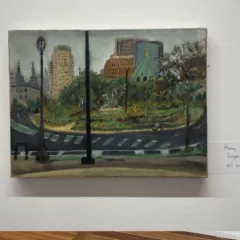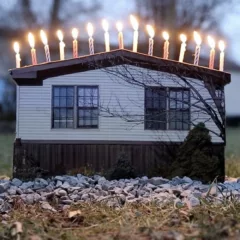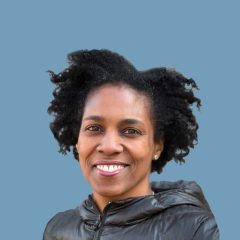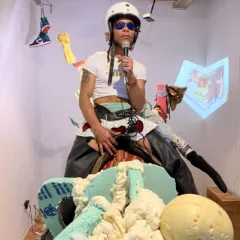—>Sam visits the studio of Colin Keefe, maker of intricate, ink drawings based on cities and cellular forms. Keefe, whose works you can see this month at Grizzly Grizzly, also runs the occasional gallery, Mount Airy Contemporary, from a space behind his house. –the artblog editors——————->
Colin Keefe creates his art while standing, drawing with a Micron pen on paper hung flat on the wall of his studio. He occasionally rotates his drawings to concentrate on different areas, alternately approaching compositions from a horizontal, vertical or upside-down perspective.
The roots of his finished works are sparsely detailed diagrams on standard 8.5 x 11” sheets of paper. These diagrams are like maps indicating the paths of exploration that Keefe will follow during the drawing process. Starting from the diagrams, Keefe’s drawings are “very free-form in terms of what happens next,” he says. Since he draws with ink, there are no mistakes – everything is incorporated into the overall design. Sometimes Keefe will intentionally disrupt his original design, “just put some blockage in the way and see what happens,” as he puts it.
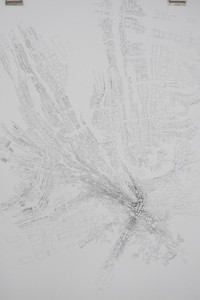
Between the box-like human structures and organic, cell-like shapes which are the primary components of the drawing style he has worked in since 2010, Keefe’s intersections precipitate change: Elements collide, combine, repel, experience near-misses, procreate, accumulate in a clump, and at times, take on a feverish velocity. The only biological process seemingly not represented in his drawings is annihilation.
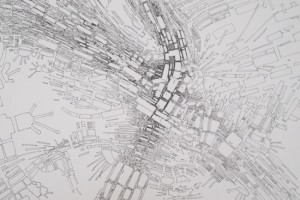
The shock of the hand-made
“With this sort of very detailed work, people, particularly younger people, 25 or younger, they’re always shocked that humans can actually make something this detailed by hand,” observes Robert Walden, who has known and exhibited Keefe’s work for fifteen years at Robert Henry Contemporary in Brooklyn, where Walden is gallery co-director. “When they see the work from across the room, because it’s so faint on the page, from 15 to 20 feet away, they can’t quite see what it is,” Walden says. “There’s this process of discovery when you approach the work and you get right close up to it. People are usually quite overwhelmed with it.”

The extreme complexity of Keefe’s works is balanced by his simple, black-and-white mark-making process. Jacque Liu, curator of “Urban Landscapes” at Grizzly Grizzly that features Keefe’s work (along with work by Fabio Fernández and Tom Lauerman), said that the simplicity of method may make Keefe’s work more accessible to viewers. “I’m really interested in what artists were thinking or feeling when they made their work,” Liu says. “With Colin’s work, it’s instant. You can be it, you can feel it … because it’s ink on paper. They [the viewers] know what it is to draw, they know what it is to put a pen to paper, even if it’s just writing.”
Obsessive works
Walden categorized Keefe’s drawings as “obsessive work,” adding, “but all of us are obsessive.” Liu agreed, saying, “Most good artists are OCD in some way, secret or not so secret. Colin’s work is definitely labor intensive. The labor speaks to process. Audience members, seeing all those different lines in there — you sort of feel the artist’s process, of what they were going through to do it.”
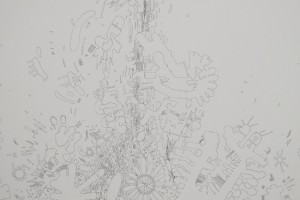
Keefe is clear in stating that his works are maps, based on cities— particularly New York City, where he lived for 13 years, and which made a strong impression on his understanding of urban landscape. But he is equally clear about his interest in biology and cellular life.
“Can a city think like a biological creature? Does a city become self-aware, ever?” are questions that Keefe says drive his work. Paolo Soleri’s ideas about “arcology,” a melding of architecture and ecology, Newton and Helen Mayer Harrison’s works in eco-art and the concept of linear cities, all ideas related to achieving a more sustainable utilization of natural and land resources, are also part of the intellectual dialogue within which Keefe works.
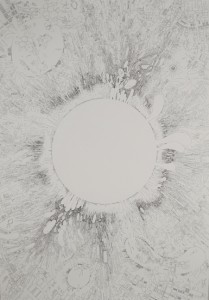
Keefe, 45, began his career by studying sculpture, earning a B.F.A. from Washington University of St. Louis in 1990 and his M.F.A. from Cranbrook Academy of Art in 1994. With an architect father, Keefe grew up around Maylines – the famous drafting tables – and engineering boards. In Keefe’s early work, his understanding of architecture and urban landscapes appeared in an integral yet inverted capacity—with the two-dimensional shapes of architectural design surfacing in or on three-dimensional forms.
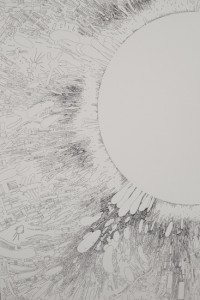
In 2001, he created “Heaven,” a seven-foot-tall sculpture made of two wooden rings, populated in the interior by plasticine models of buildings. In later works, Keefe continued to foreground the urban-design aspect of his works, creating balsa tables with city models on top. It was isometric sketches for these city designs, however, intended to inform his sculpture practice, which gradually led Keefe to leave sculpture and focus completely on drawings – brand new ground, unrelated to his art school experiences. “I’m making these objects that aren’t flat, but they’re maps,” Keefe says of his thinking at the time.
Telling a human story

When I visited Keefe’s studio for this article, he had just returned from a vacation that included stops at Joshua Tree, the Grand Canyon, and other famous sites of the American Southwest. While those sites impressed him with the beauty of “this giant machine flying through space that we’re all living on that has all of these moving parts,” geological formations and natural landscapes don’t really inform his work. “That’s not the story I’m trying to tell,” he says. “This is a human story.”
“Urban Landscapes,” opening September 6, 2013, at Grizzly Grizzly, features the work of Colin Keefe and the collaborative work of Fabio Fernández and Tom Lauerman.


